Networking
Fetch, Increment, Decode and Execute.
A network consists of co axial cable which might plug into an Ethernet port which plugs into the Ethernet interface cards and then connects to a network. It might be a connection to a wireless network via a wireless router.
Servers aren't hardware they just contain the software to run the server. This could be things like the mail server, active directory and general use files like policies and procedures. So you can set up a server on any home computer, laptop or specialised server set up.
End User Clients are the computers on each network.
How a network works.
Requests is sent > Sends a packet> Network send a packet> It chops it up into little bits> Sends results back.
Start with the a discussion on how a network works and how a network might communicate and then give out the cut up bits of the network packets to everyone in the class.
NetworkPackets.xls
Networking1a
Networking1b
Andy
|
Header and Sender Name |
Cath |
Name of Recipient |
10 |
Number of Packets |
1 |
Packet Order |
1 |
Number of Characters |
What |
Message to be Sent |
Stop |
End of Message |
Then the
Warriors of the net video explains about packet transfer and how it works.
https://www.youtube.com/watch?v=L8VpthhRaEg
More details about networking can be found in AGBOnline's networking documents.
Networking terms include:
TCPIP-Transmission Control Internet Control Protocol
SMTP-Simple Mail Transfer Protocol
POP3-Post Office 3 Protocol
WEP Wireless Ethernet Protocol
HTTP-Hypertext Transfer Protocol.
HTTPS-Hypertext Transfer Protocol Secure
FTP- File Transfer Protocol
DNS-Domain Name Server
LAN-Local Area Network
WAN-Wide Area Network
MAN-Metropolitan Area Network
PAN-Personal Area network
Peer to Peer Networks
Virtual Private Networks.
Dark Net and www.torproject.org
Bitcoin- Currency available to use online.
DNS - Domain Name Server looks are the www.root-server.org.
DHCP- Dynamic Host Configuration Protocol.
Static IP- Stays the same.
Dynamic IP- Changes as and when necessary.
A URL will have an associated IP address.
Diamond DNS means that your hosted site even if the IP address changes the address will be adjusted so that everyone can still find your site.
IPV6 is a new internet protocol with more numbers because we are running out.
IP Address
To find your own IP address you can go to:
www.whatsmyipaddress.com
An IP address is split into 4 parts containing 3 numbers.
eg. 194.066.175.090
Which is represented as 194.66.175.90
IP addresses are mostly static but can also be changed depending on the circumstances.
The range of numbers in an IP address are 0-255, 0-255, 0-255, 0-255.
You can also find your IP address by using the Command Prompt and typing Pinging a web address or by typing IPConfig.
URL
The acronym URL used to stand for Universal Resource Locator but now it stands for Uniform Reform Locator.
Wireless.
Wireless Networks and Wireless Access Points can be used anywhere and also in the home. A router can provide the source for the Wi Fi network in your house and a Wireless Access point or a repeater can boost the signal. You can also carry a network signal around your home by using a Power over Ethernet socket. This transfers the network signal through the house using the internal electricity cables and can be cheaper than installing network cables in your home.
TCPIP Method
TCP is Transmission
IP is the connection
Send the packet.
Send and receive the packet number 1. (1 packet)
Send packet number 2 and 3. (2 packets)
Send packet number 4, 5, 6 and 7. (4 packets)
Send packet 8, 9, 10, 11, 12, 13, 14 and 15. (8 packets)
Send packet 16, 17, 18, 19, 20, 21, 22, 23, 24, 25, 26, 27, 28, 29, 30, 31. (16 packets)
The maximum number of packets is 1058.
Network Topologies include:
I have followed Andy's example for this one and used the descriptions from the internet and Harvard referenced it.
Wikipedia. 2016. Network topology - Wikipedia, the free encyclopedia. [ONLINE] Available at: https://en.wikipedia.org/wiki/Network_topology. [Accessed 29 July 2016].
"Point-to-point[edit]
The simplest topology with a dedicated link between two endpoints. Switched point-to-point topologies are the basic model of conventional telephony. The value of a permanent point-to-point network is unimpeded communications between the two endpoints. The value of an on-demand point-to-point connection is proportional to the number of potential pairs of subscribers and has been expressed as Metcalfe's Law.
Permanent (dedicated)
Easiest to understand, of the variations of point-to-point topology, is a point-to-point communications channel that appears, to the user, to be permanently associated with the two endpoints. A child's tin can telephone is one example of a physical dedicated channel.
Within many switched telecommunications systems, it is possible to establish a permanent circuit. One example might be a telephone in the lobby of a public building, which is programmed to ring only the number of a telephone dispatcher. "Nailing down" a switched connection saves the cost of running a physical circuit between the two points. The resources in such a connection can be released when no longer needed, for example, a television circuit from a parade route back to the studio.
Switched:
Using circuit-switching or packet-switching technologies, a point-to-point circuit can be set up dynamically and dropped when no longer needed. This is the basic mode of conventional telephony.
Main article: Bus network
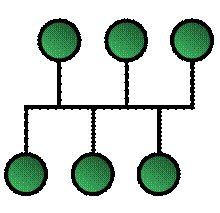
Bus network topology
In local area networks where bus topology is used, each node is connected to a single cable, by the help of interface connectors. This central cable is the backbone of the network and is known as the bus (thus the name). A signal from the source travels in both directions to all machines connected on the bus cable until it finds the intended recipient. If the machine address does not match the intended address for the data, the machine ignores the data. Alternatively, if the data matches the machine address, the data is accepted. Because the bus topology consists of only one wire, it is rather inexpensive to implement when compared to other topologies. However, the low cost of implementing the technology is offset by the high cost of managing the network. Additionally, because only one cable is utilized, it can be the single point of failure.
Linear bus
The type of network topology in which all of the nodes of the network are connected to a common transmission medium which has exactly two endpoints (this is the 'bus', which is also commonly referred to as the backbone, or trunk) – all data that is transmitted between nodes in the network is transmitted over this common transmission medium and is able to be received by all nodes in the network simultaneously.[1]
Note: When the electrical signal reaches the end of the bus, the signal is reflected back down the line, causing unwanted interference. As a solution, the two endpoints of the bus are normally terminated with a device called a terminator that prevents this reflection.
Distributed bus
The type of network topology in which all of the nodes of the network are connected to a common transmission medium which has more than two endpoints that are created by adding branches to the main section of the transmission medium – the physical distributed bus topology functions in exactly the same fashion as the physical linear bus topology (i.e., all nodes share a common transmission medium).
Main article: Star network
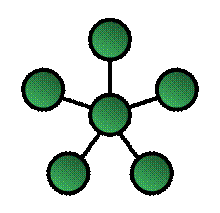
Star network topology
In local area networks with a star topology, each network host is connected to a central hub with a point-to-point connection. So it can be said that every computer is indirectly connected to every other node with the help of the hub. In Star topology, every node (computer workstation or any other peripheral) is connected to a central node called hub, router or switch. The switch is the server and the peripherals are the clients. The network does not necessarily have to resemble a star to be classified as a star network, but all of the nodes on the network must be connected to one central device. All traffic that traverses the network passes through the central hub. The hub acts as a signal repeater. The star topology is considered the easiest topology to design and implement. An advantage of the star topology is the simplicity of adding additional nodes. The primary disadvantage of the star topology is that the hub represents a single point of failure.
Extended star
A type of network topology in which a network that is based upon the physical star topology has one or more repeaters between the central node and the peripheral or 'spoke' nodes, the repeaters being used to extend the maximum transmission distance of the point-to-point links between the central node and the peripheral nodes beyond that which is supported by the transmitter power of the central node or beyond that which is supported by the standard upon which the physical layer of the physical star network is based.
If the repeaters in a network that is based upon the physical extended star topology are replaced with hubs or switches, then a hybrid network topology is created that is referred to as a physical hierarchical star topology, although some texts make no distinction between the two topologies.
Distributed Star
A type of network topology that is composed of individual networks that are based upon the physical star topology connected in a linear fashion – i.e., 'daisy-chained' – with no central or top level connection point (e.g., two or more 'stacked' hubs, along with their associated star connected nodes or 'spokes').
Main article: Ring network
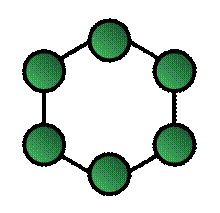
Ring network topology
A ring topology is a bus topology in a closed loop. Data travels around the ring in one direction. When one node sends data to another, the data passes through each intermediate node on the ring until it reaches its destination. The intermediate nodes repeat (retransmit) the data to keep the signal strong.[4] Every node is a peer; there is no hierarchical relationship of clients and servers. If one node is unable to retransmit data, it severs communication between the nodes before and after it in the bus.
Main article: Mesh networking
The value of fully meshed networks is proportional to the exponent of the number of subscribers, assuming that communicating groups of any two endpoints, up to and including all the endpoints, is approximated by Reed's Law.
Fully connected network[edit]
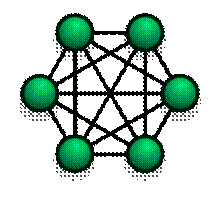
Fully connected mesh topology
In a fully connected network, all nodes are interconnected. (In graph theory this is called a complete graph.) The simplest fully connected network is a two-node network. A fully connected network doesn't need to use packet switching or broadcasting. However, since the number of connections grows quadratically with the number of nodes:
= n ( n − 1 ) 2 . {\displaystyle c={\frac {n(n-1)}{2}}.\,} 
This makes it impractical for large networks.
Partially connected network[edit]
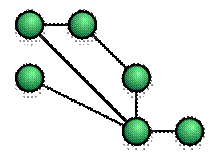
Partially connected mesh topology
In a partially connected network, certain nodes are connected to exactly one other node; but some nodes are connected to two or more other nodes with a point-to-point link. This makes it possible to make use of some of the redundancy of mesh topology that is physically fully connected, without the expense and complexity required for a connection between every node in the network."
Teaching Ideas.
Lesson 1. How a network works.
Requests is sent > Sends a packet> Network send a packet> It chops it up into little bits> Sends results back.
Start with the a discussion on how a network works and how a network might communicate and then give out the cut up bits of the network packets to everyone in the class.
NetworkPackets
Andy
|
Header and Sender Name |
Cath |
Name of Recipient |
10 |
Number of Packets |
1 |
Packet Order |
1 |
Number of Characters |
What |
Message to be Sent |
Stop |
End of Message |
Youtube video
Warriors of the net video explains about packet transfer and how it works.
https://www.youtube.com/watch?v=L8VpthhRaEg
More details about networking can be found in AGBOnline's networking documents.
Lesson
Add the missing words.
Networking1a
Networking1b
NetworkPackets
Other Useful things include:
http://www.harvardgenerator.com/
Play network games and quizzes on www.teach-ct.com/gcse_computing
Show networks with taibah.net/main/project/net-seal/animations/hub.
www.hegartymaths.co.uk
General Teaching Advice for controlling a class.
1. Count Down 10-1.
2. Get all students to get in shoe size order outside the classroom.
3. Growl at one students. (Everyone else stops to look)
4. Bang something on the desk to attract attention.
5. Ring a bell.
6. Be unpredictable and don't give an inch.

